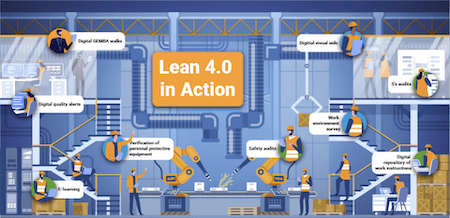
Over the years ‘Lean’ has become one of the most practiced methodologies for manufacturing industries to become more profitable. Lean principles are quite generic and are now used by the services industry also.
At the core of the Lean is the philosophy of generating more value for your customer by reducing waste. As manufacturing embraces Industry 4.0 the question is if this is a new trend that will replace Lean on the shop floor.
Actually, before any such thing happens to the detriment of the progress made over the years with Lean, it must be understood that the question is wrong. These are two different things. But at the same time Industry 4.0 can be a potent tool to support Lean.
While Lean relies on practices and methods to reduce waste, increase value and become more effective and efficient, Industry 4.0 is all about creating an ecosystem of connected machines and processes that provides the necessary intelligence in a timely manner for taking the right action.
We examine below a few of the Lean concepts and practices that can be augmented by the automated information and intelligence system derived from Industry 4.0. (In some cases, we shall use the Japanese terms that are used in the context of Lean, since Lean is actually a synonym for TPS or Toyota Production System which originated in Toyota in Japan.)
Muda is the waste of non-value add activities. The most famous sub-categories of this waste category are the wastes of Transport, Inventory, Motion, Waiting, Overproduction, Over-processing and Defects. With an Industry 4.0 backbone, information from material, products, material handling equipment, transportation vehicles, machines, testing equipment and even humans who handle the processes can travel and be analysed very quickly to minimize waste from all of these sources. Read about an example here on how IBM has created a visual inspection method using an IoT solution that reduces inspection time and supports reduction of defects.
Mura is the waste of inconsistency. Practitioners of statistical process control (SPC) and Six Sigma understand the value of a consistent process. Inconsistent or ‘out-of-control’ processes produce waste by increasing defects, raising inventory and waiting time and doing overproduction. When processes generate real-time data, it is possible to detect inconsistency rapidly and even self-regulate to remove the inconsistency as rapidly.
Additionally, Mura indicates the waste that happens due to irregularities caused by imbalance of demand and capacity that impact resource and operator availability and utilization. Lean techniques for leveling load such as heijunka and Kanban can be augmented by the real-time information and data analytics that are generated using the information backbone provided by the connected assets.
Muri is the waste of excessive stresses and strain that is inflicted upon both humans and machines. The just-in-time production processes aided by information and analytics can considerably reduce the undue stresses and strains on assets and even enhance productive life.
No problem can be solved effectively and from the root without these – so says the Toyota Production System. Gemba means the real place. In other words, you have to be at the real place of the problem to understand it properly. Similarly, Gembutsu refers to the real thing. You cannot solve a problem without seeing or touching the real thing. Genjitsu refers to real data. Lean is data driven and without real data a problem cannot be solved permanently.
Whilst, the information highway created by Industry 4.0 can ensure Genjitsu or Real Data, very soon we may see immersive technologies such as augmented reality (AR) help in Gemba and Gembutsu (real place, real thing, almost!) so that technicians can study and troubleshoot remotely.
At the heart of Industry 4.0 (some may prefer to call it the edge) are the sensors that can be attached to machines and devices. Such sensors can play a major part in mistake proofing processes so that faults, failures and defects are prevented. Data from sensors attached to jigs and fixtures, dies and tools can raise alarms or stop processes when anomalies are detected.
We talk about autonomous cars these days. The word autonomation came directly from the terminology used in the TPS, translated from the word jidoka in Japanese. This means providing hi-tech sensing equipment in machines that will prevent the machines from producing defects. The connection of Jidoka with Industry 4.0 is obvious.
As is evident from the above we can expect Lean Manufacturing and Management to be more successful with the support of Industry 4.0, which is expected to play a supplementary role to Lean by providing real data, at real time with actionable intelligence. Conversely, Lean can drive implementation of Industry 4.0 by drawing up goals, objectives and plans that provide inputs for the Industry 4.0 implementation plan.
Designed by W3Squad